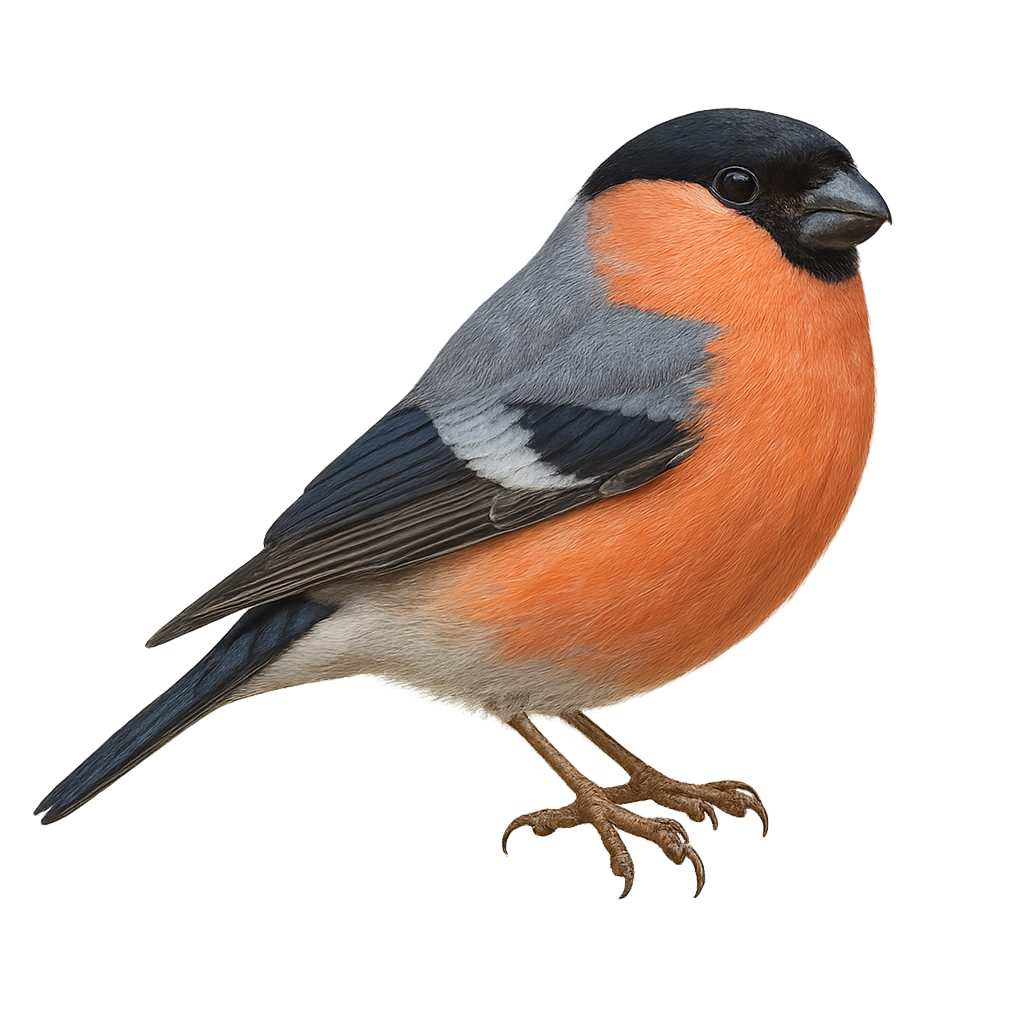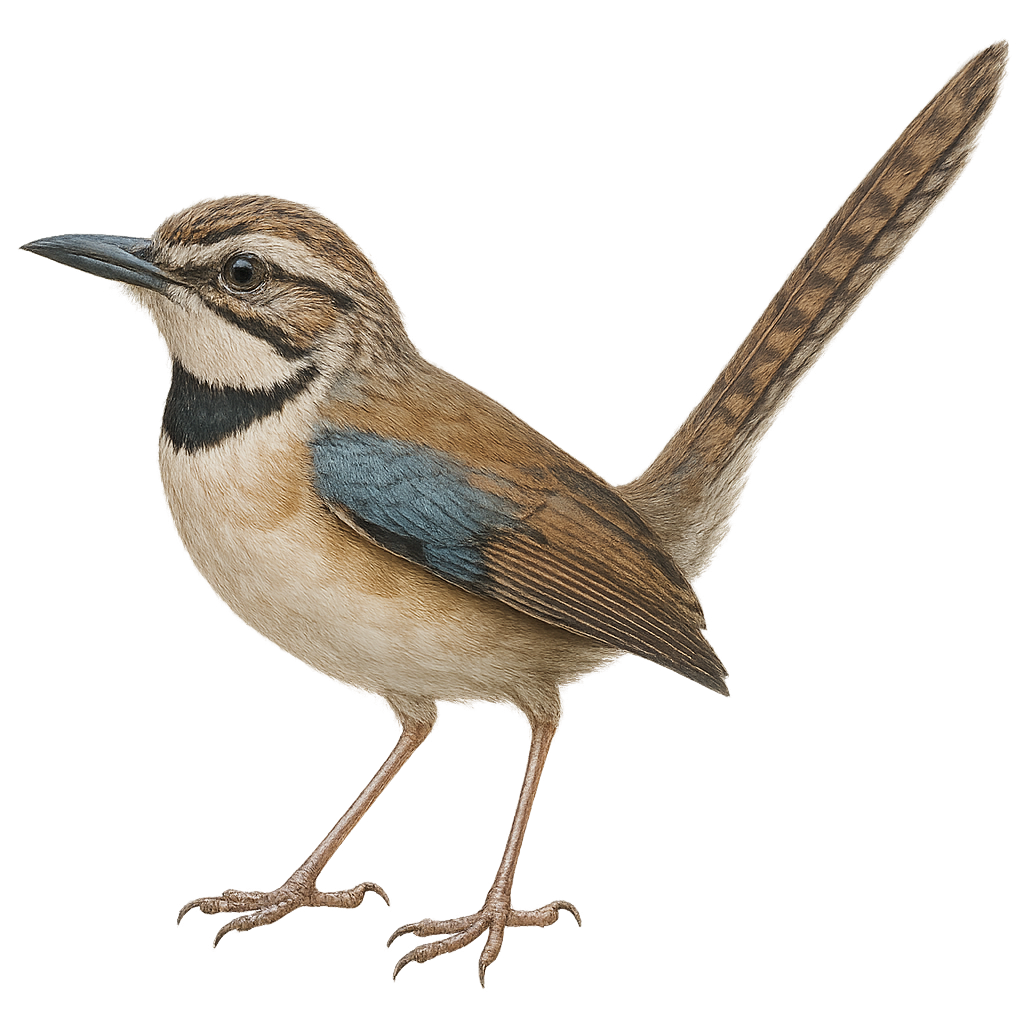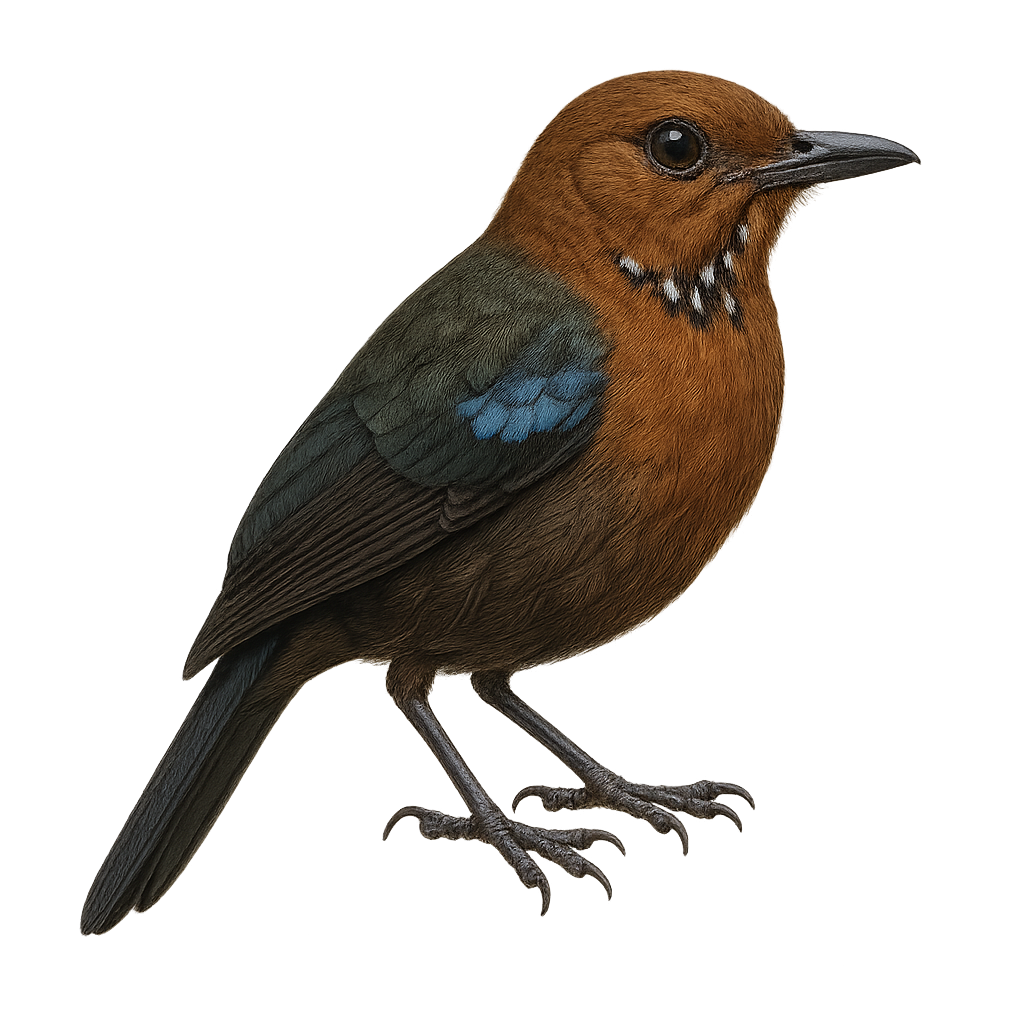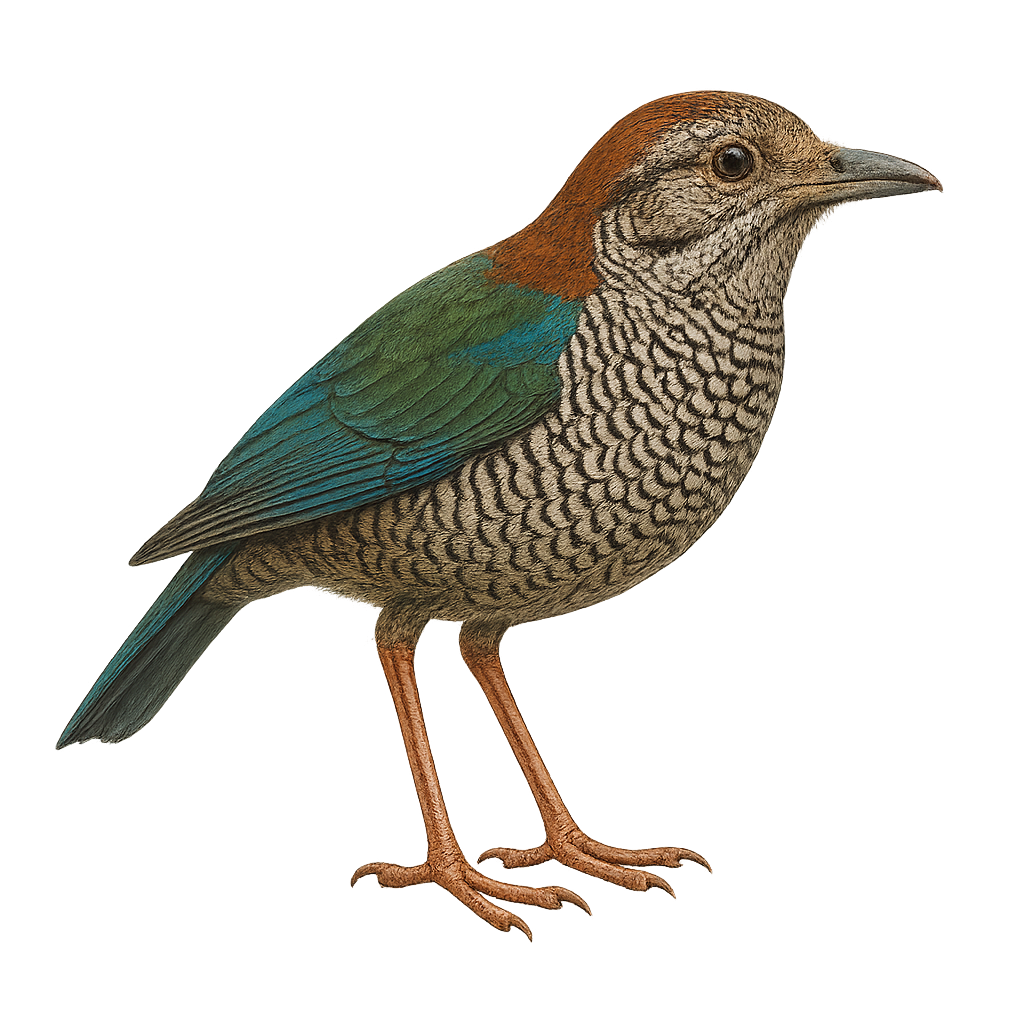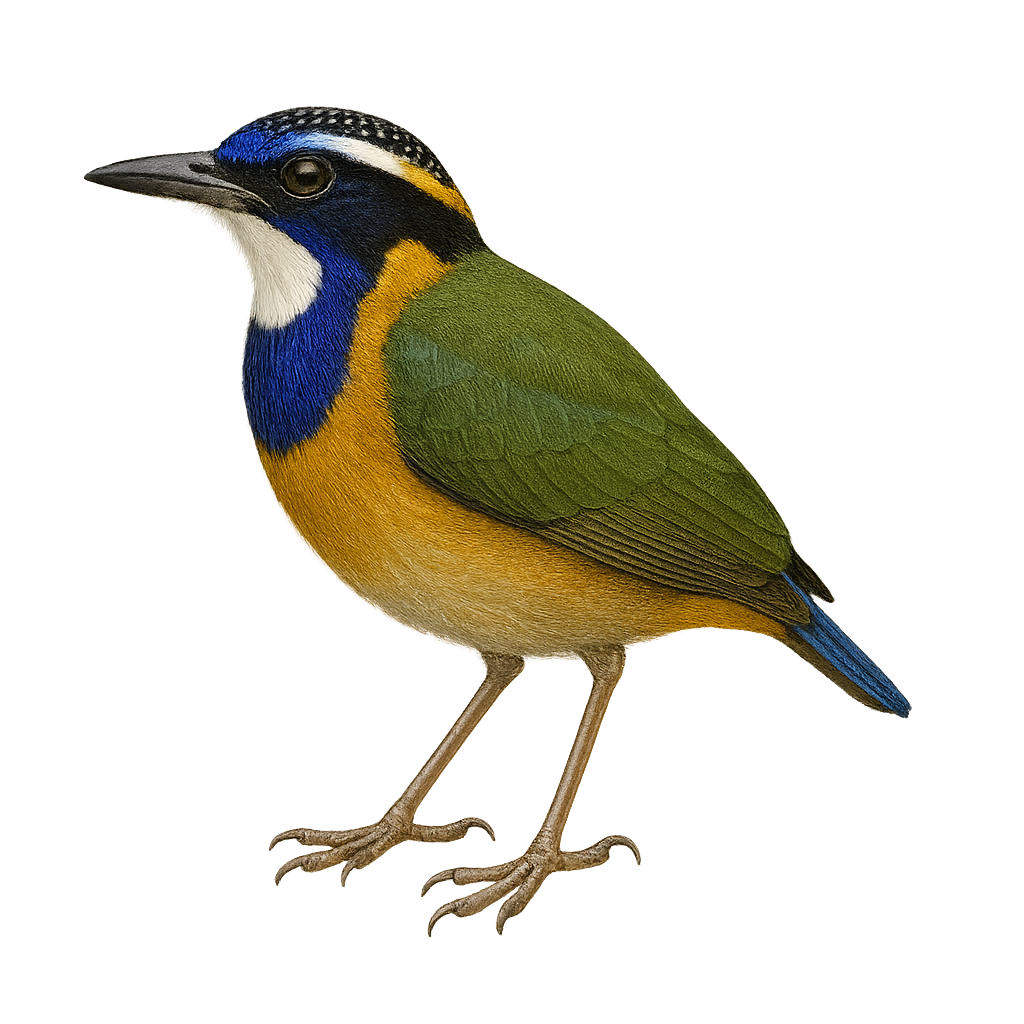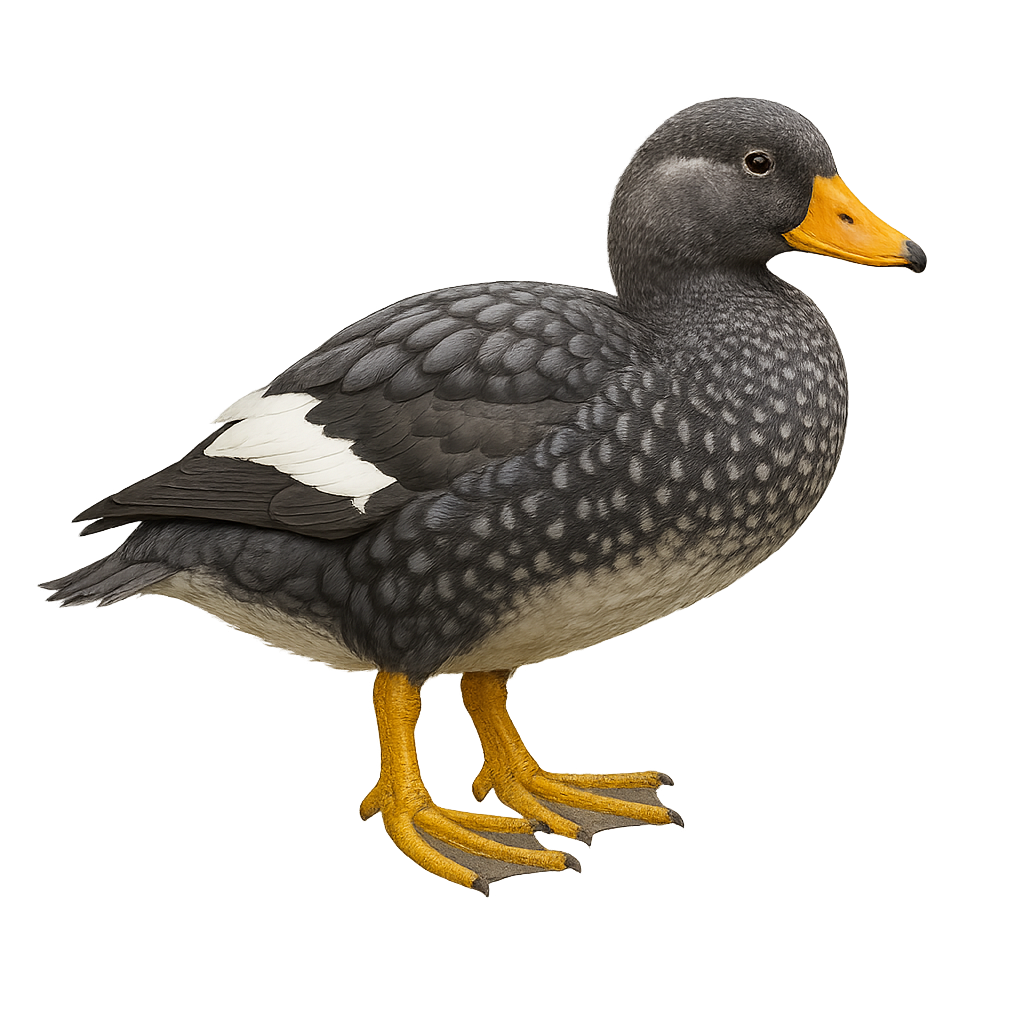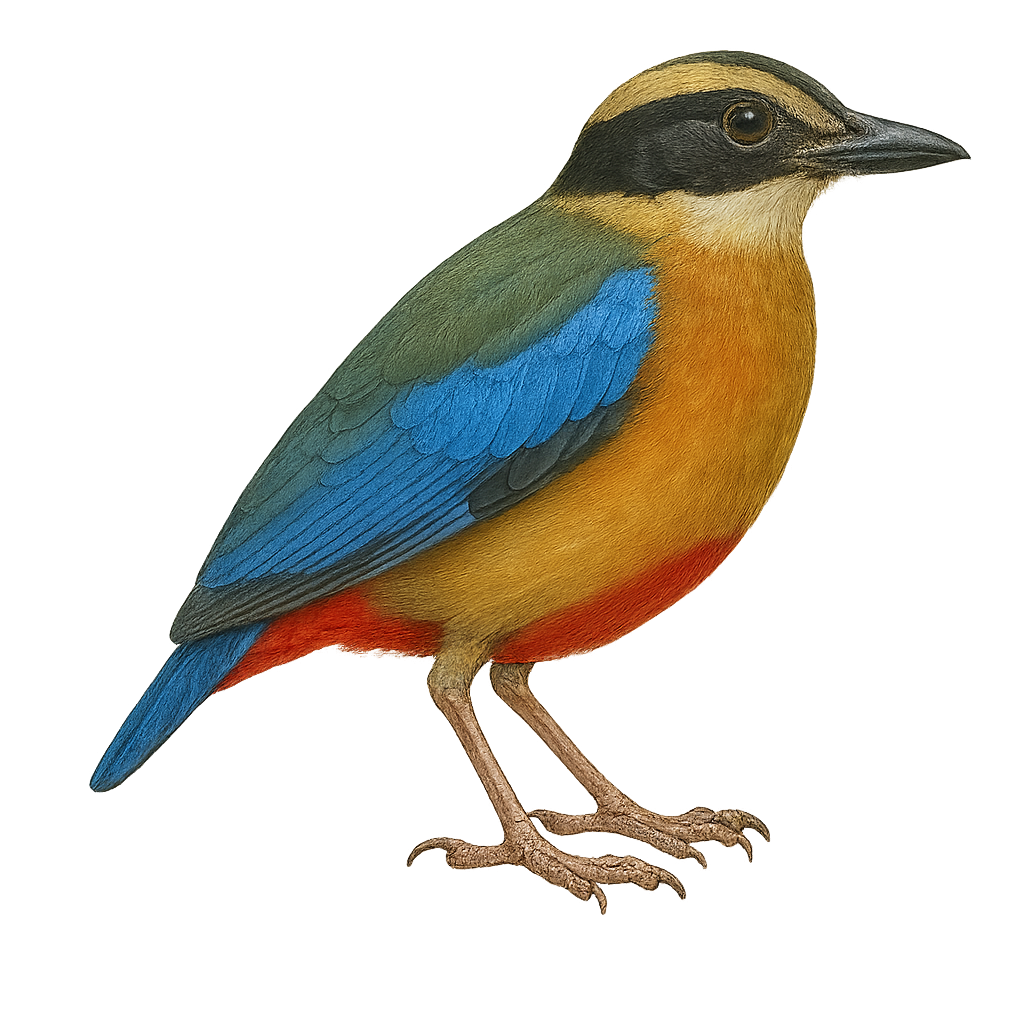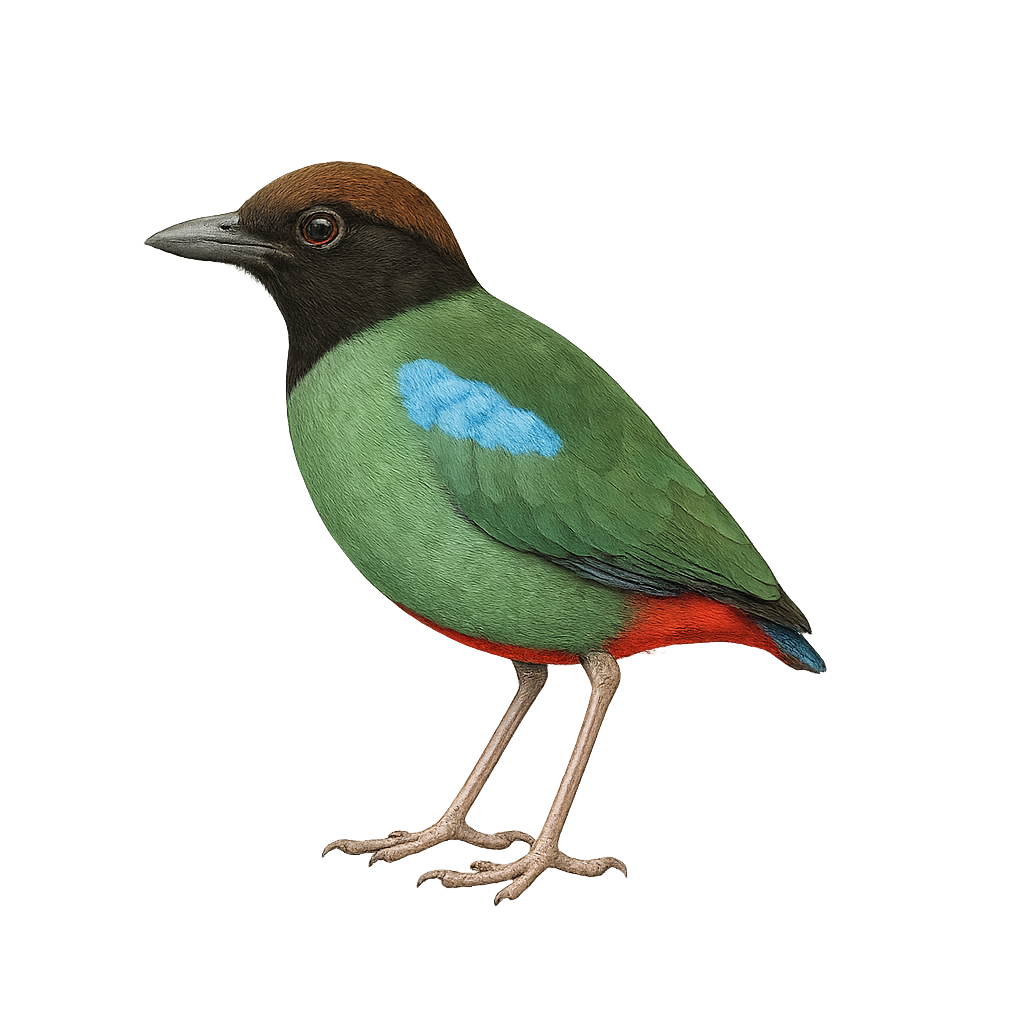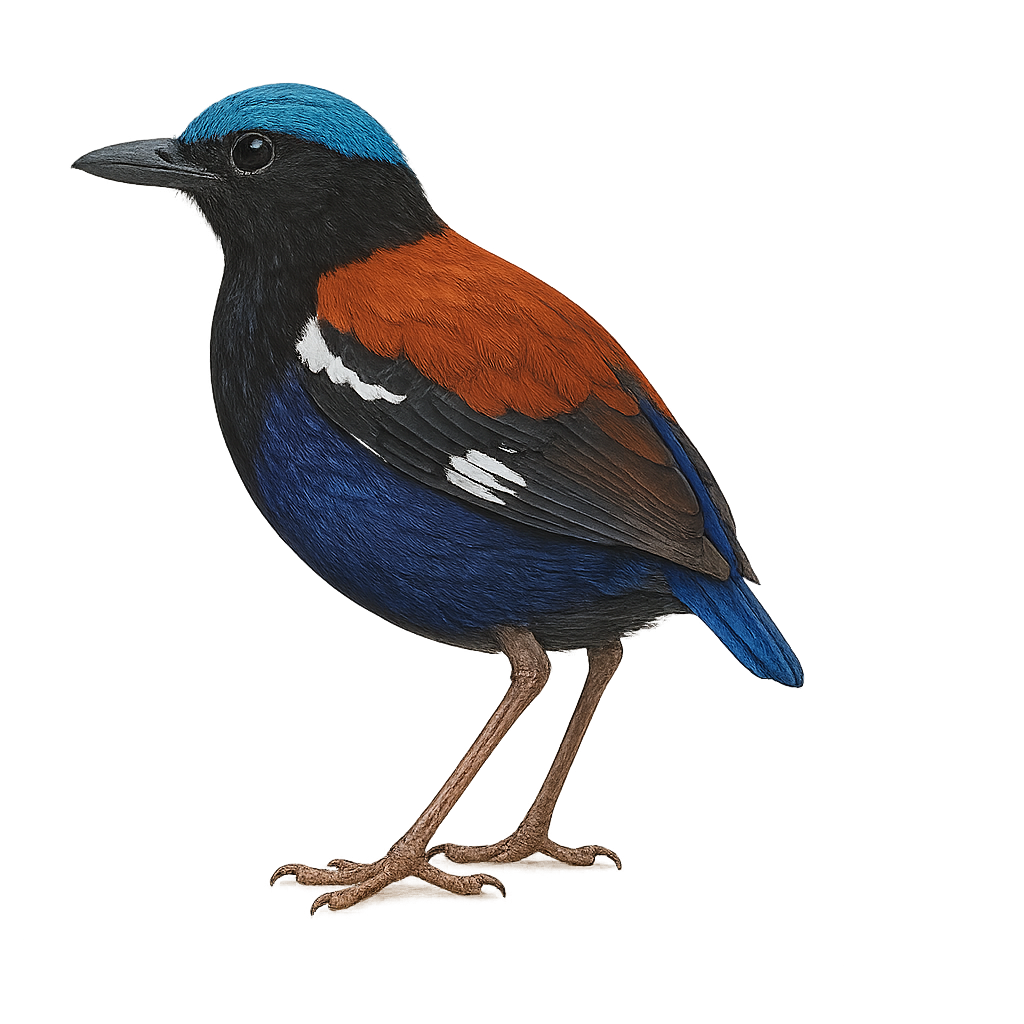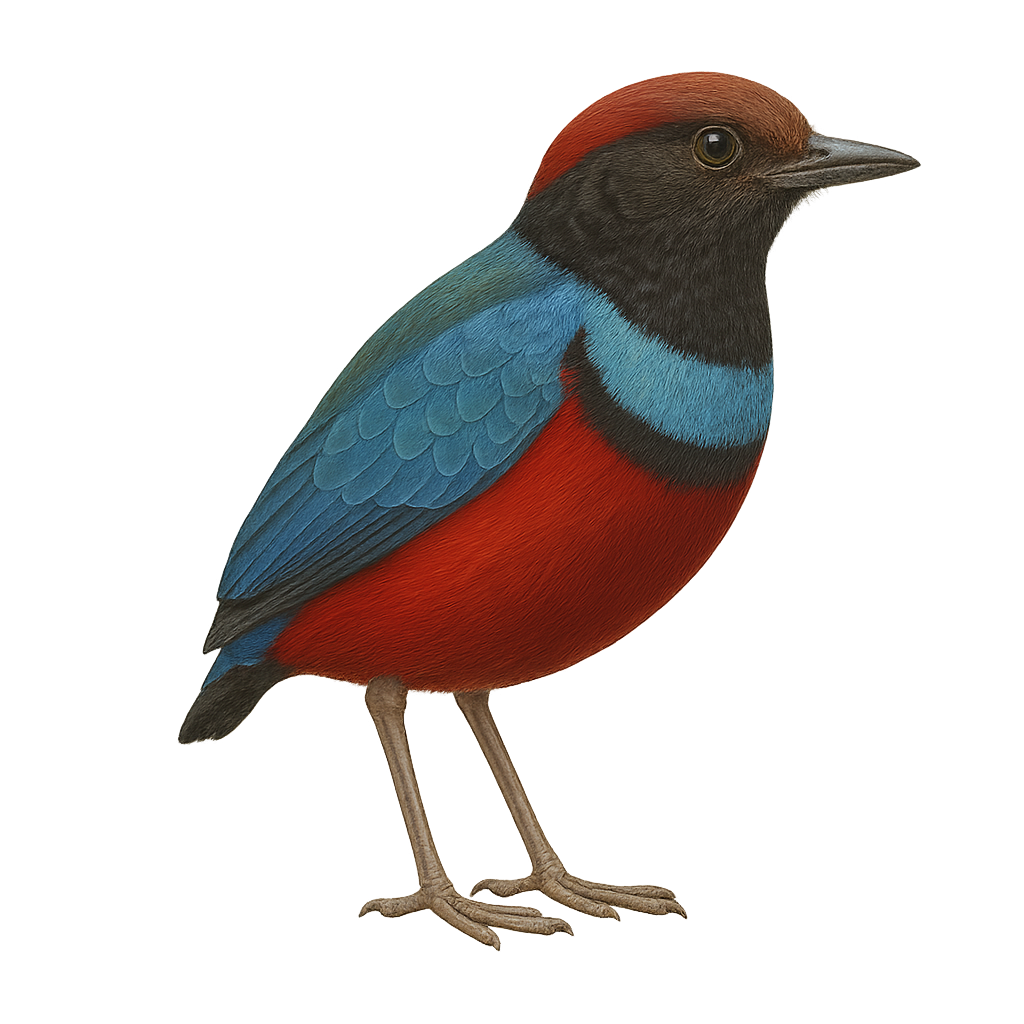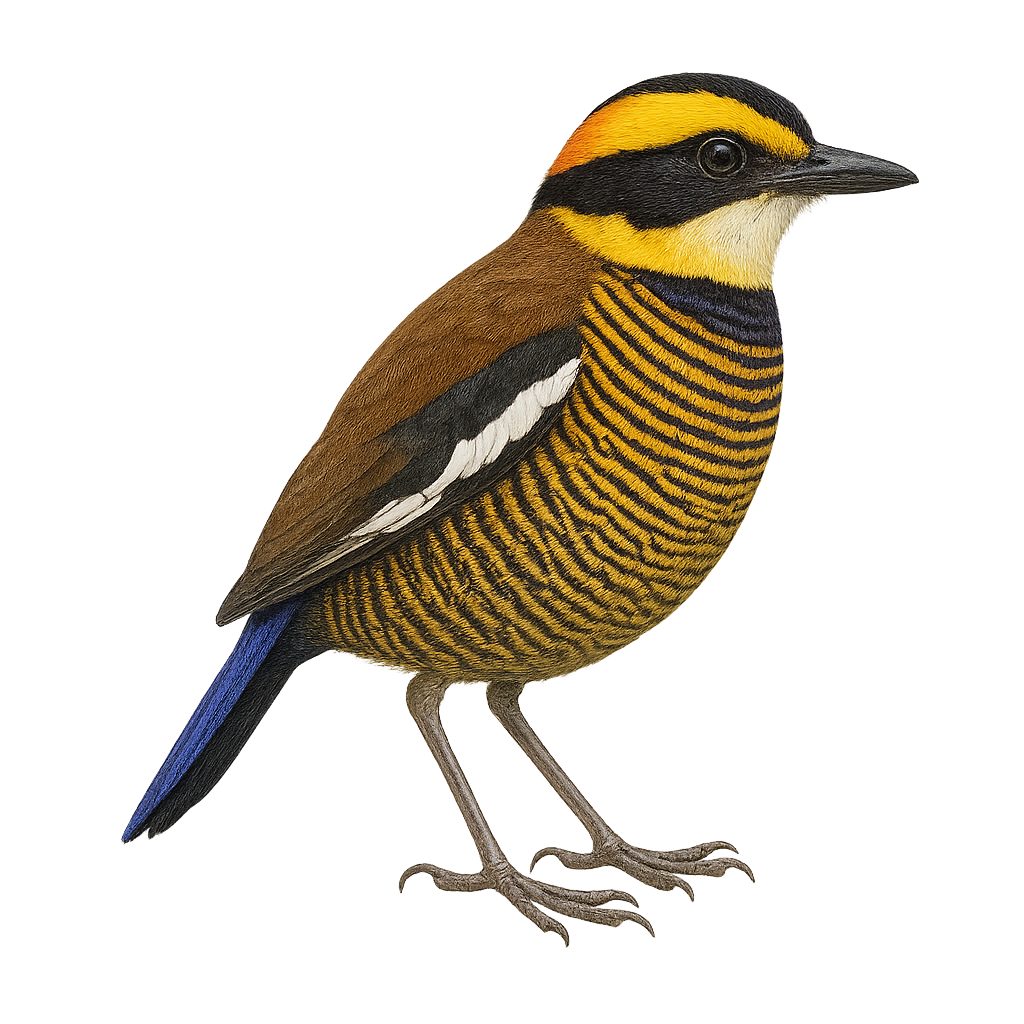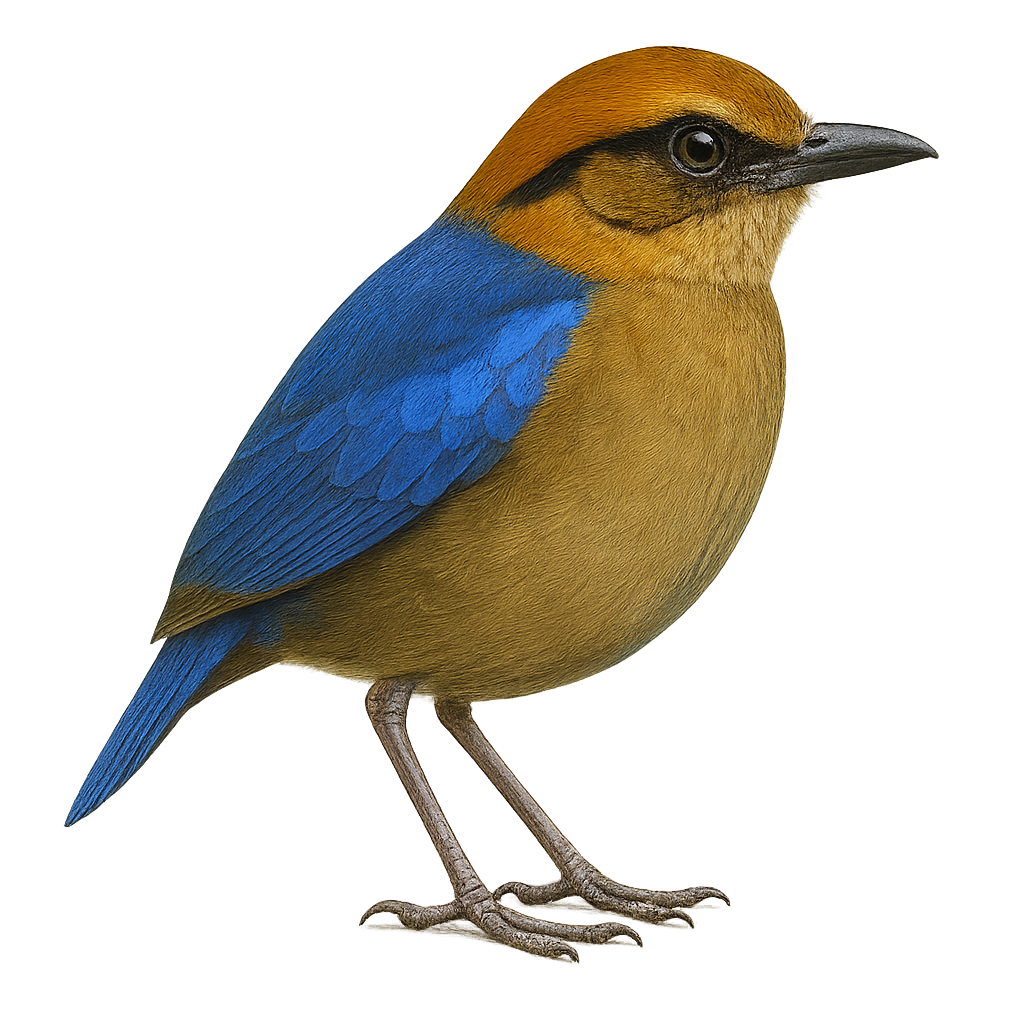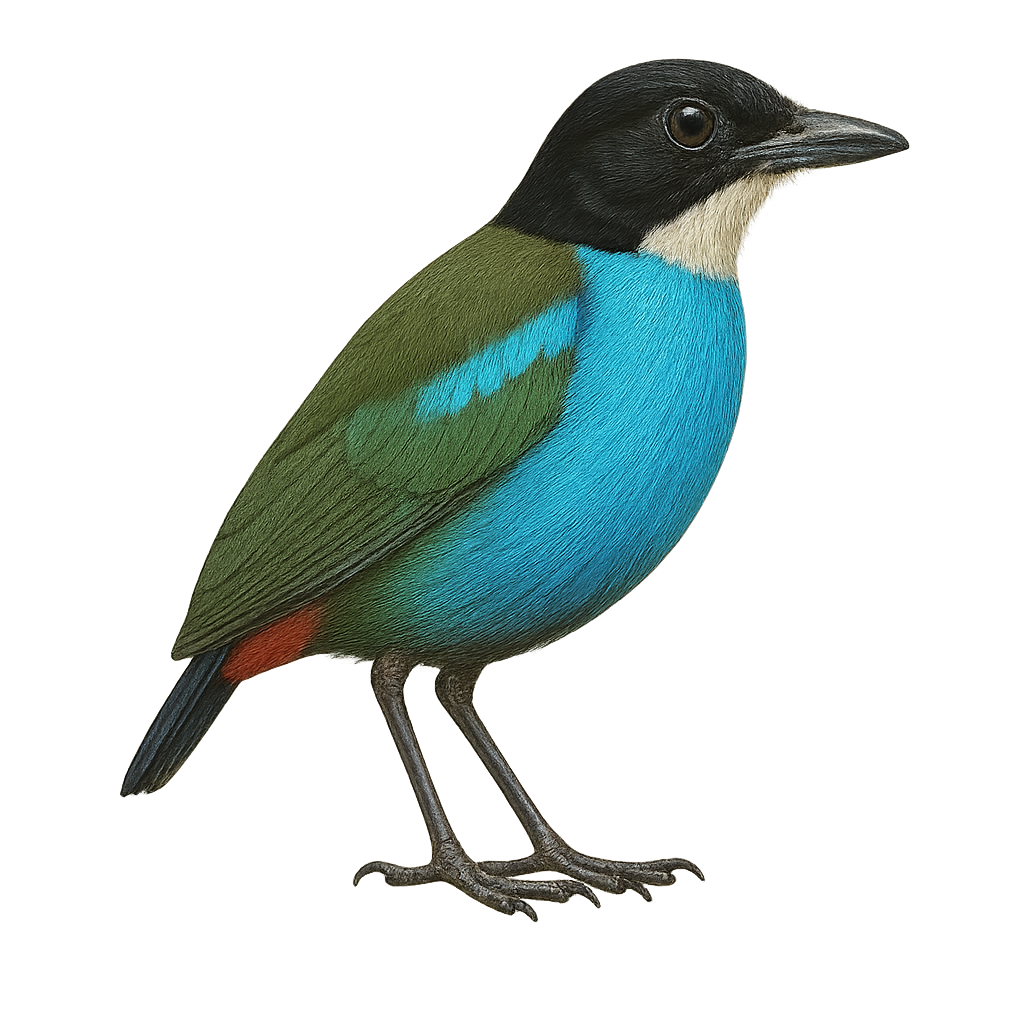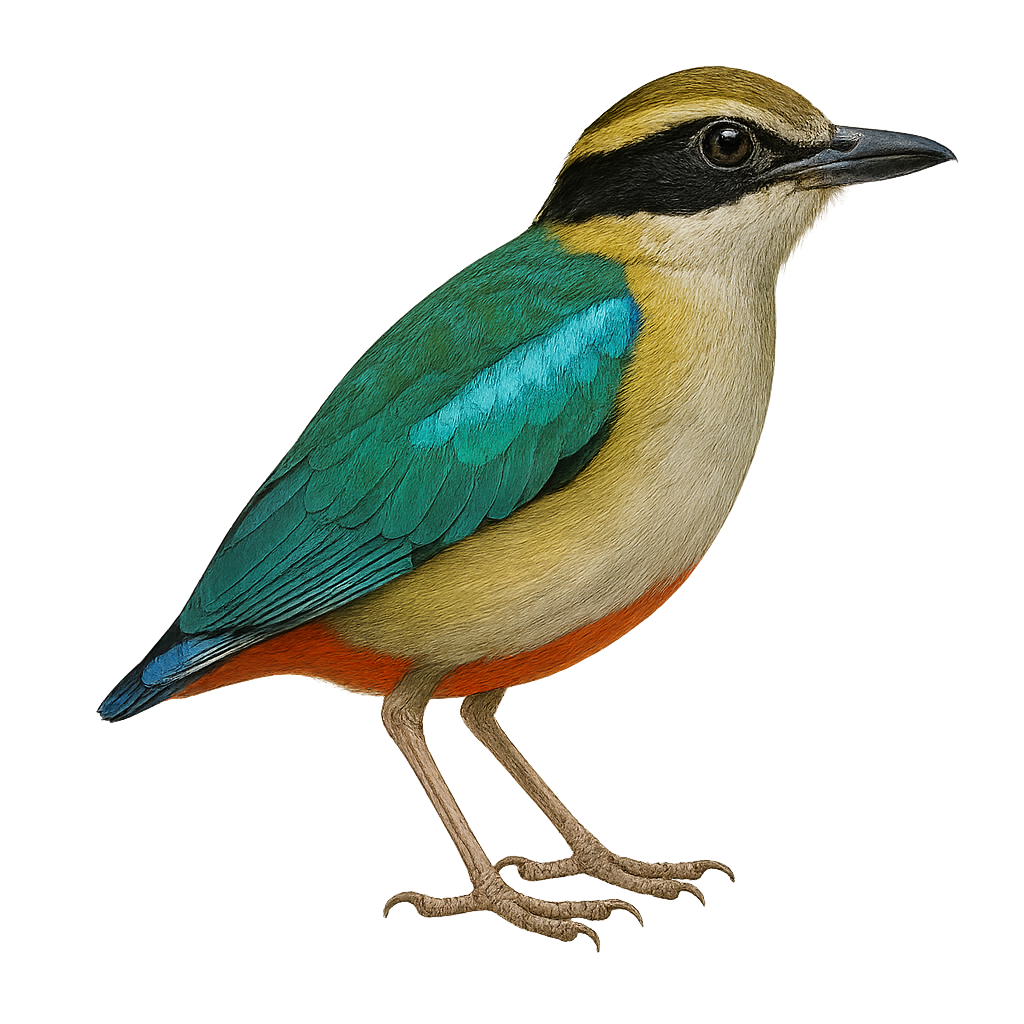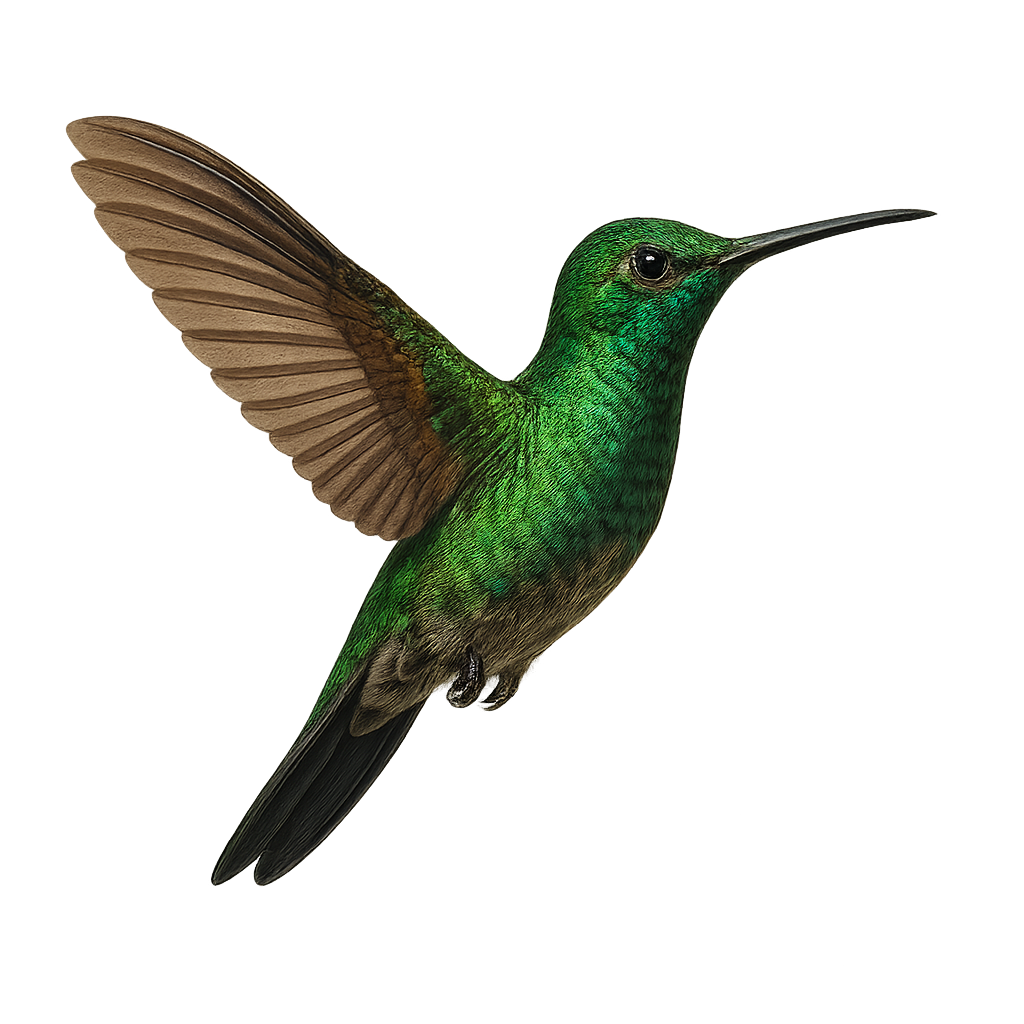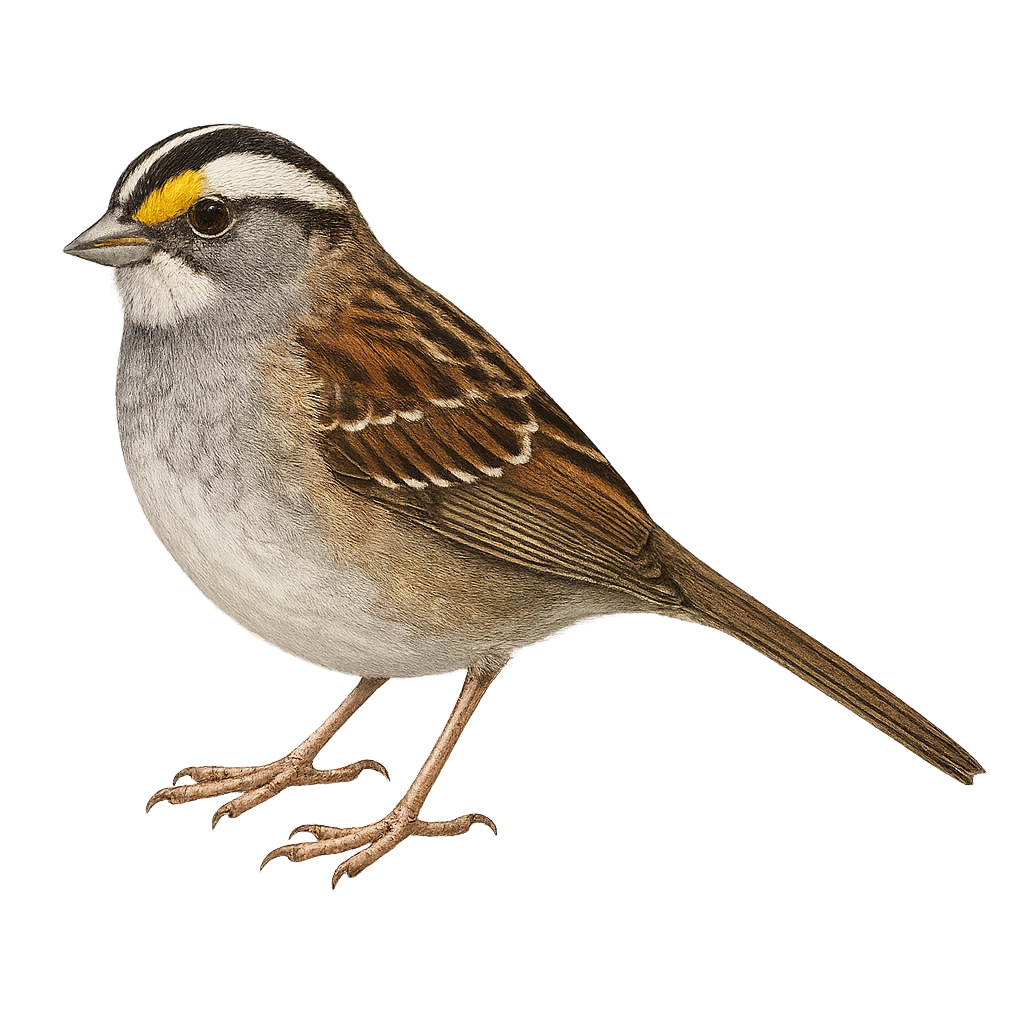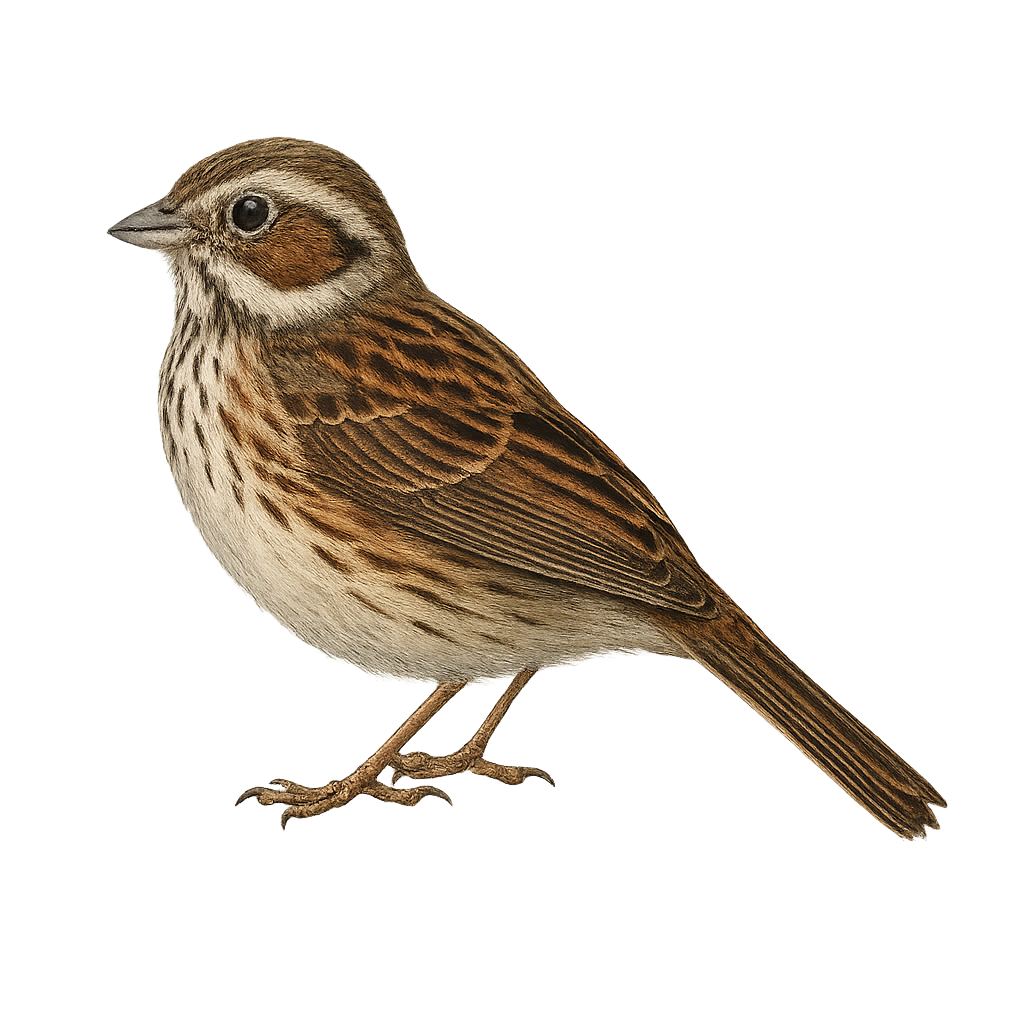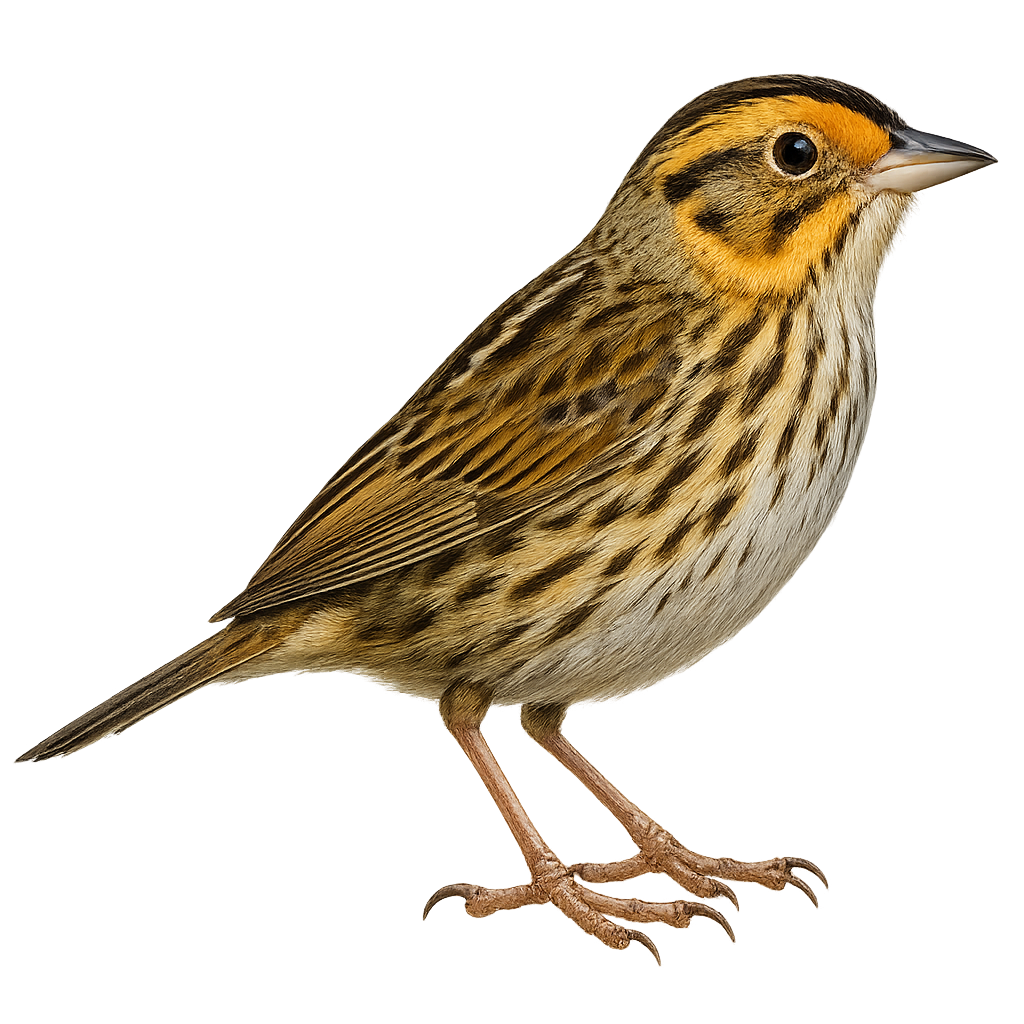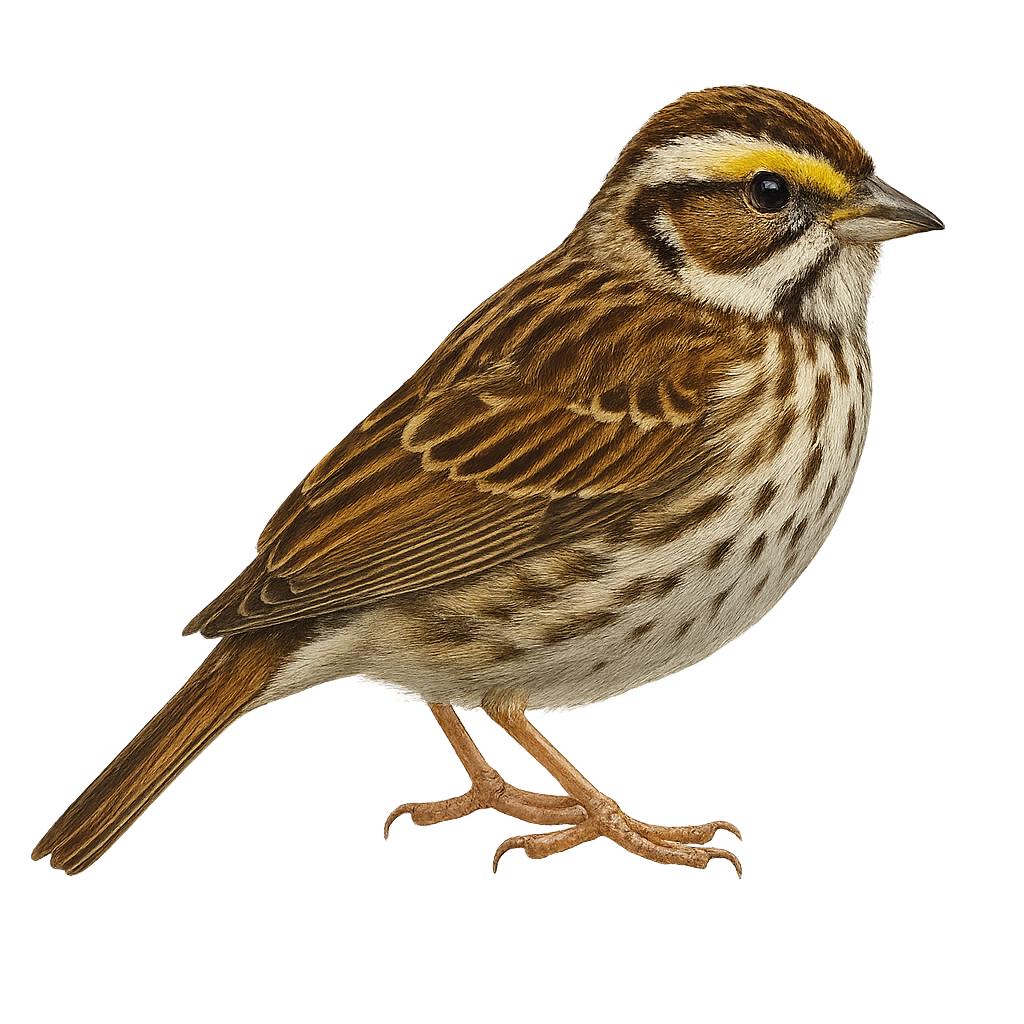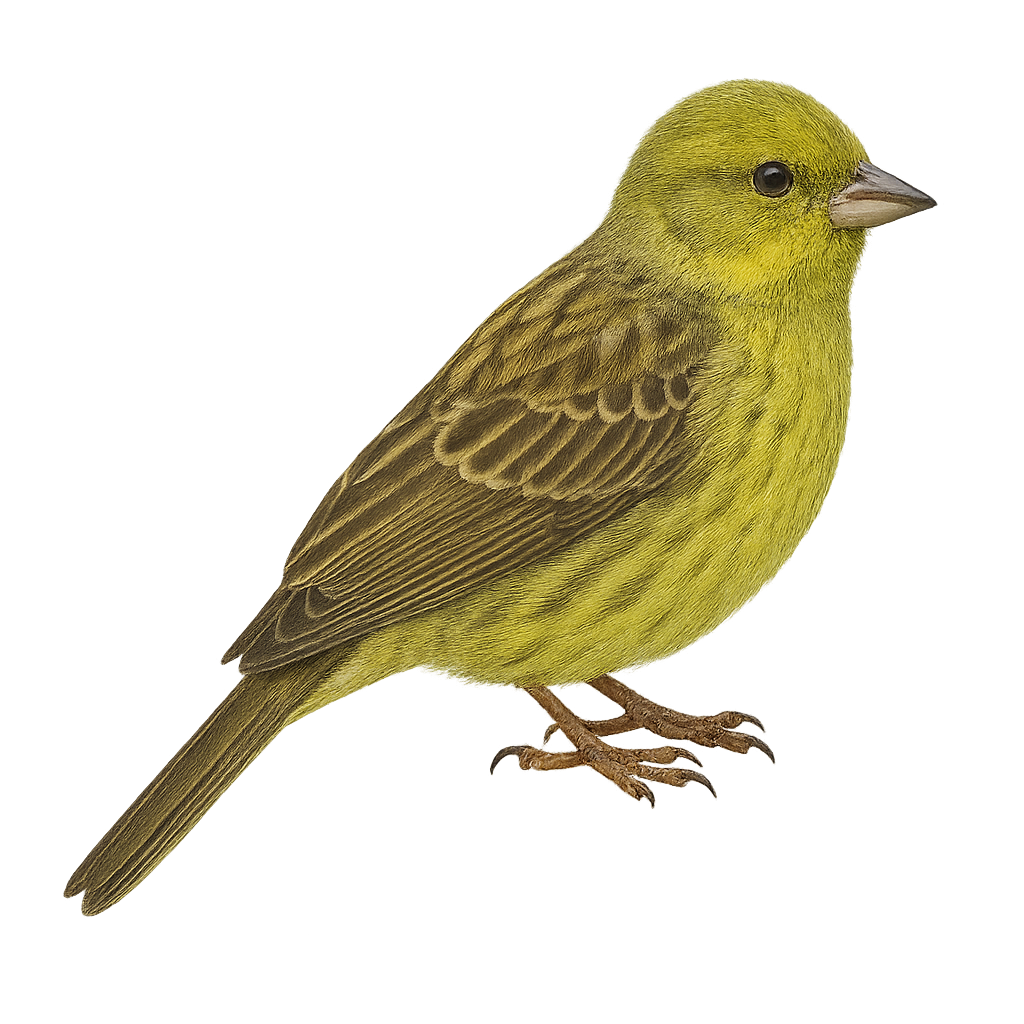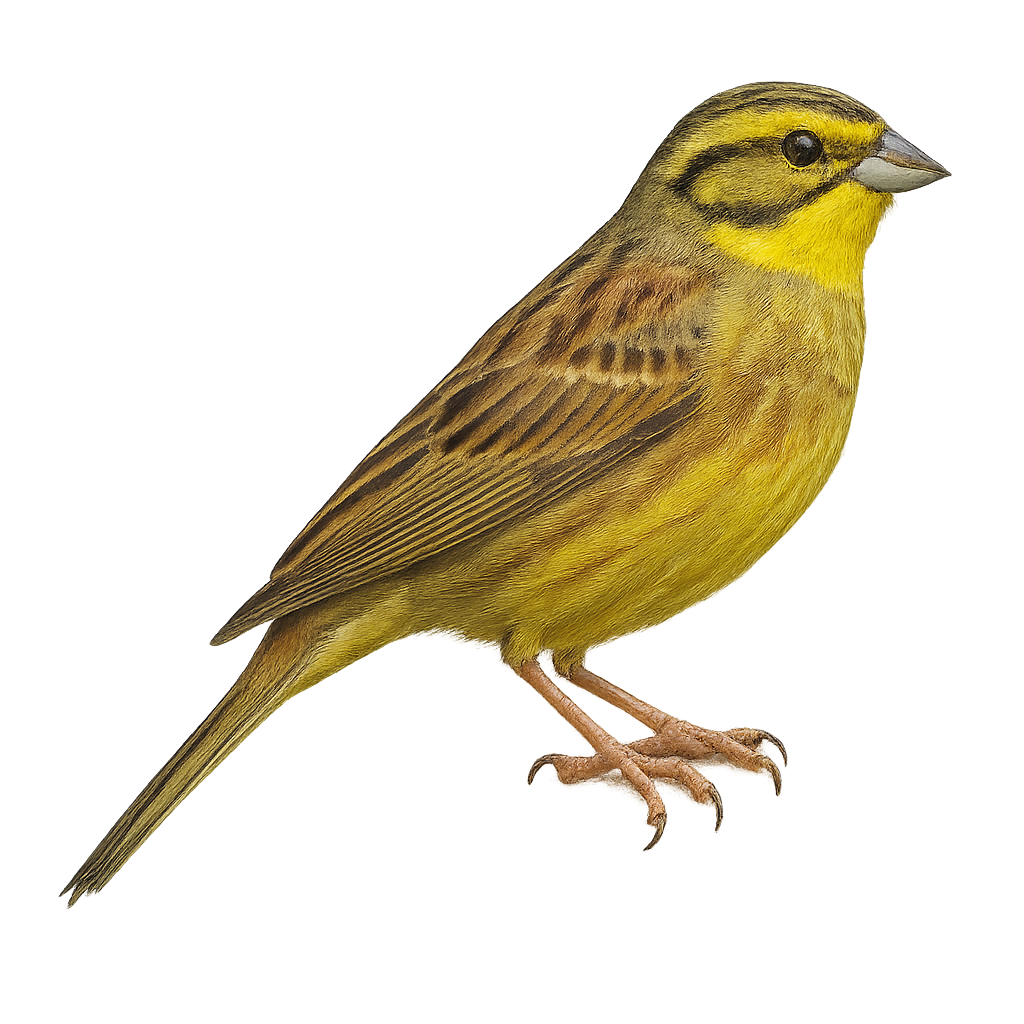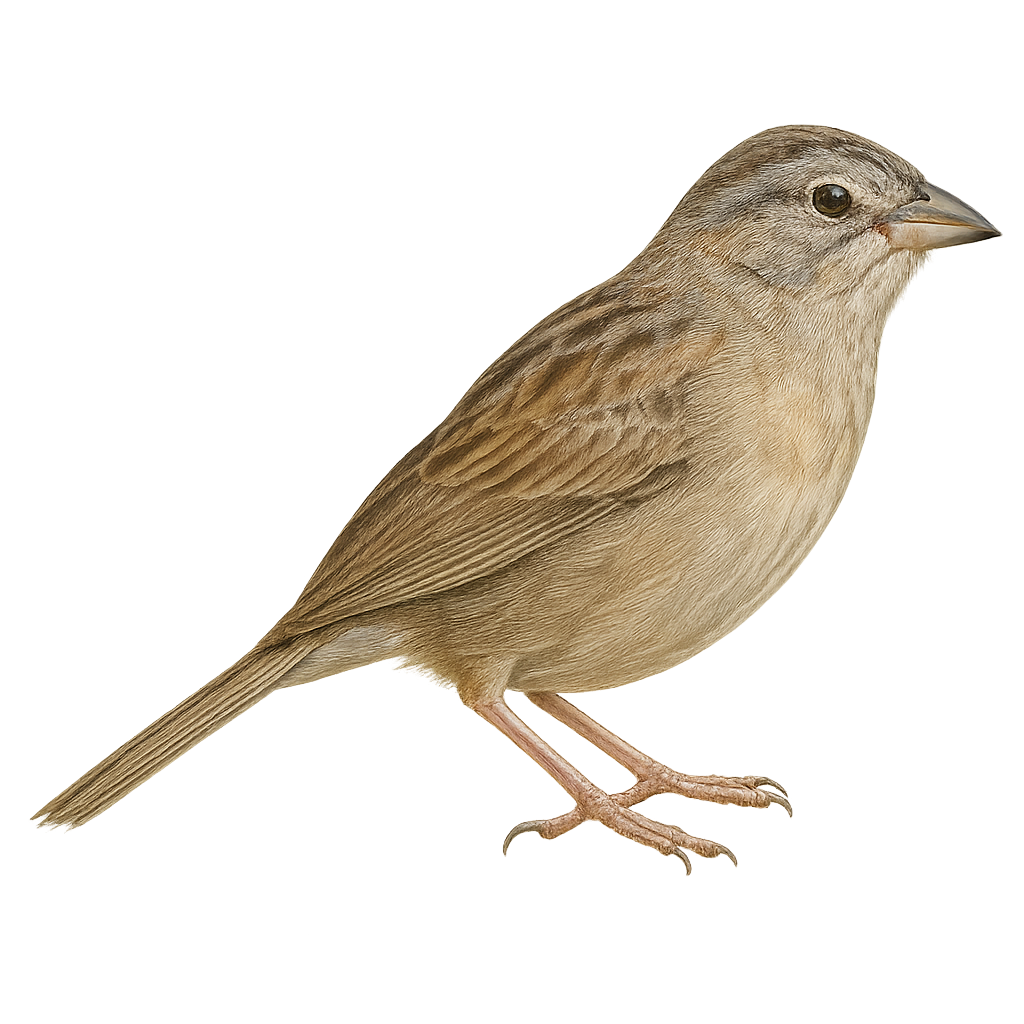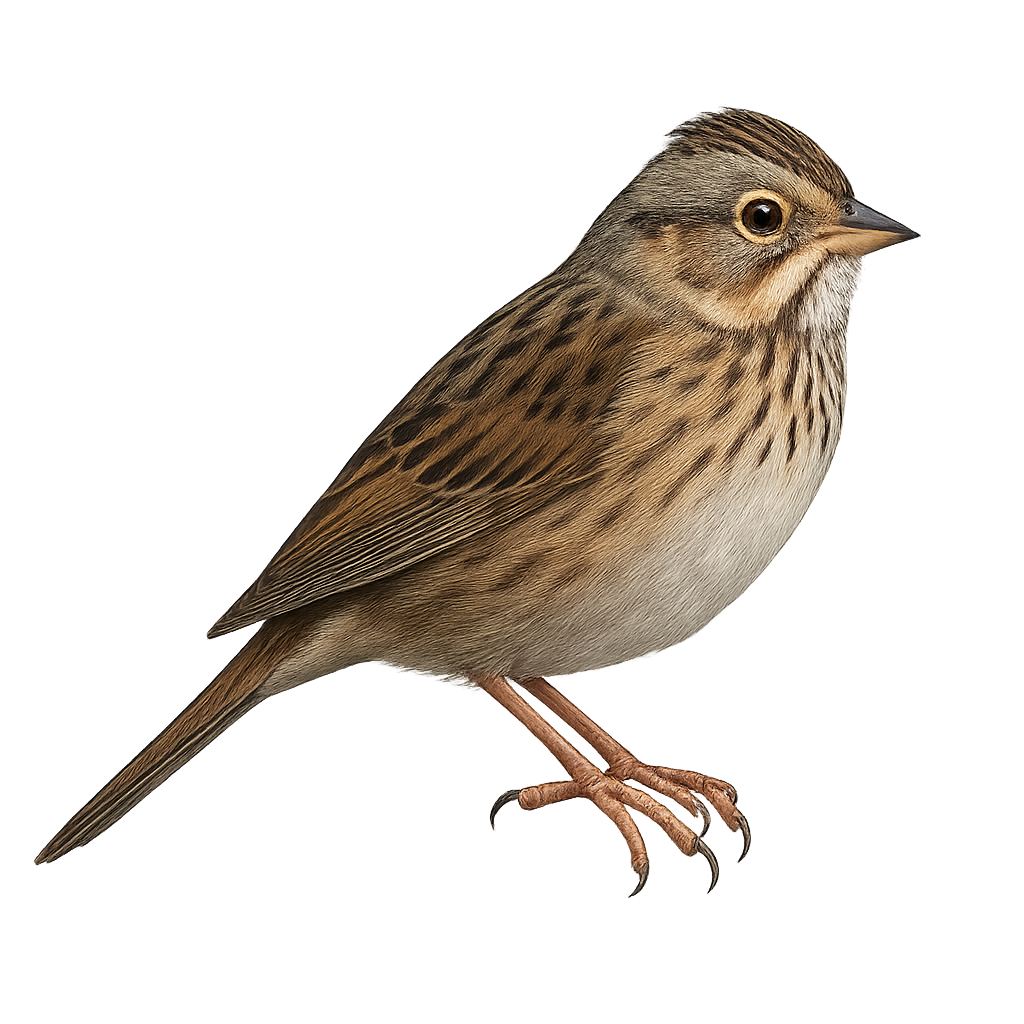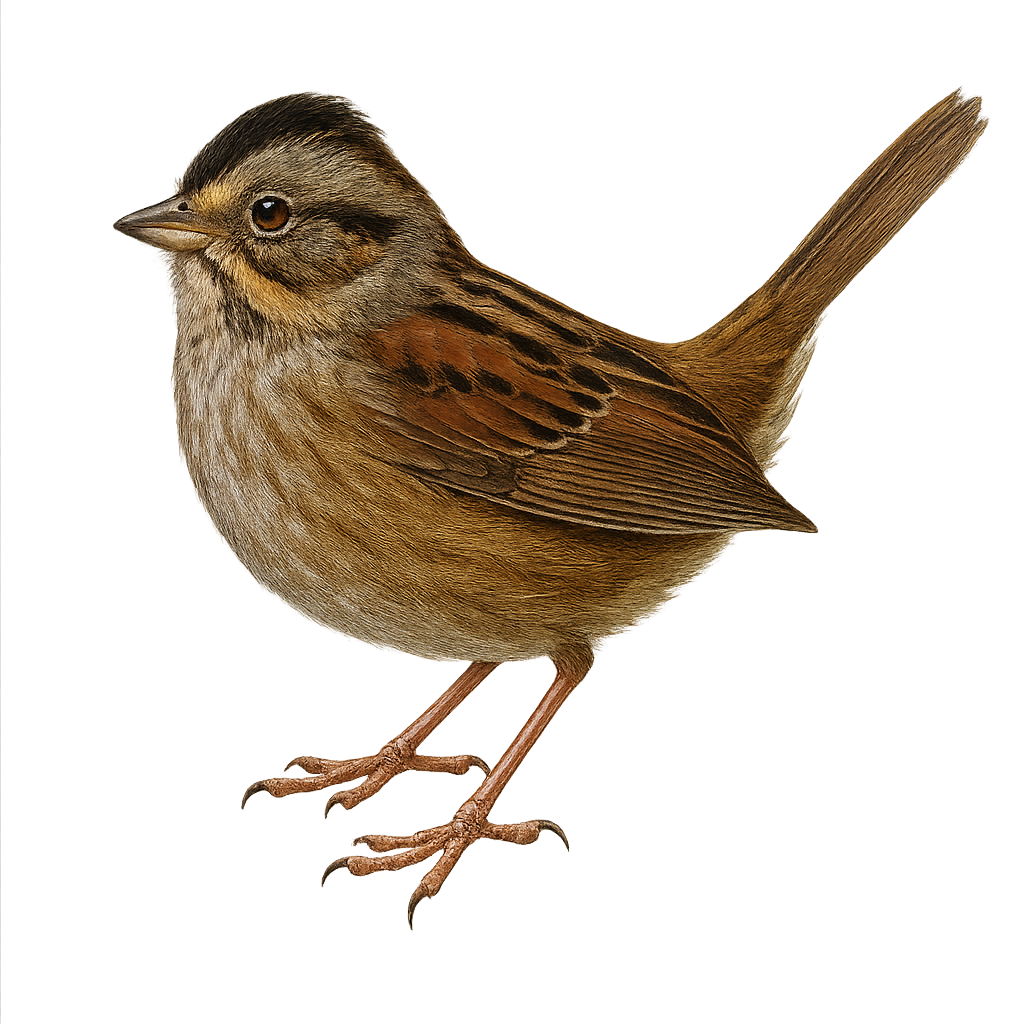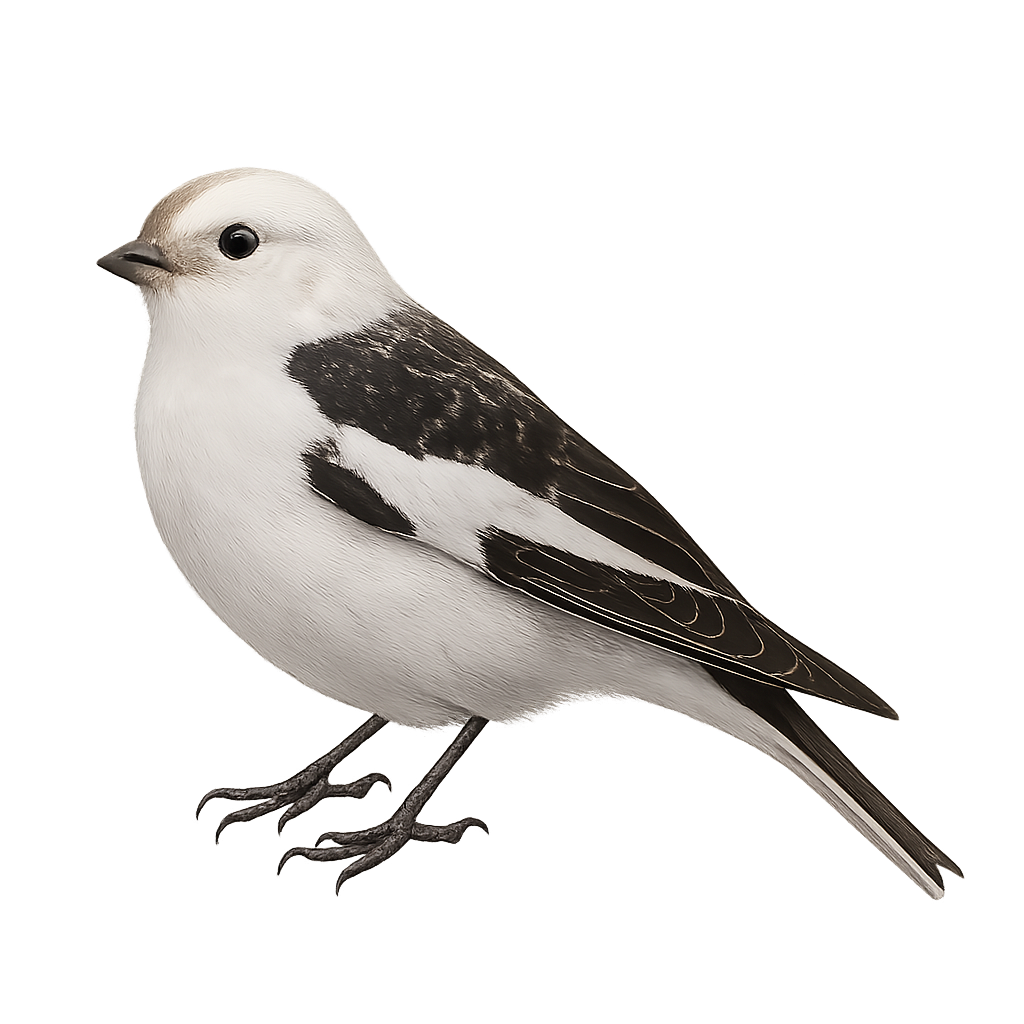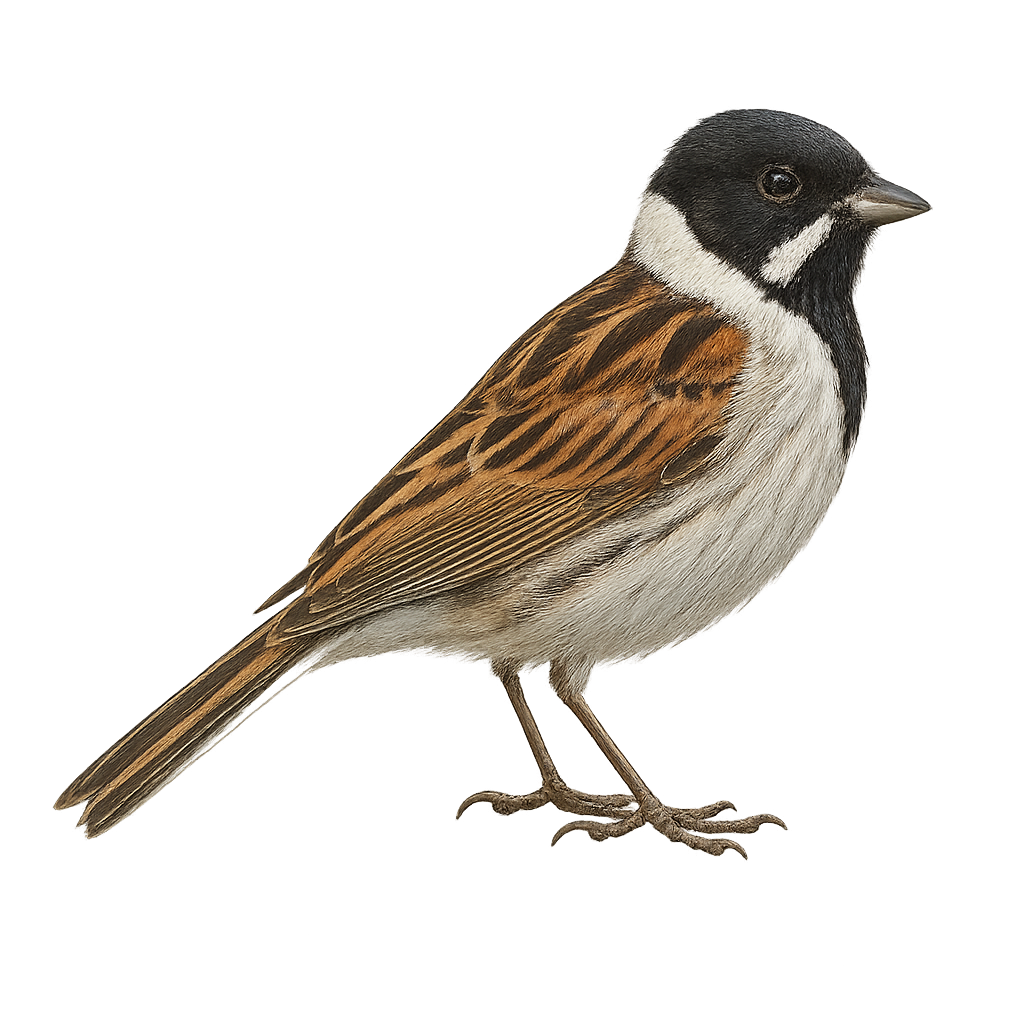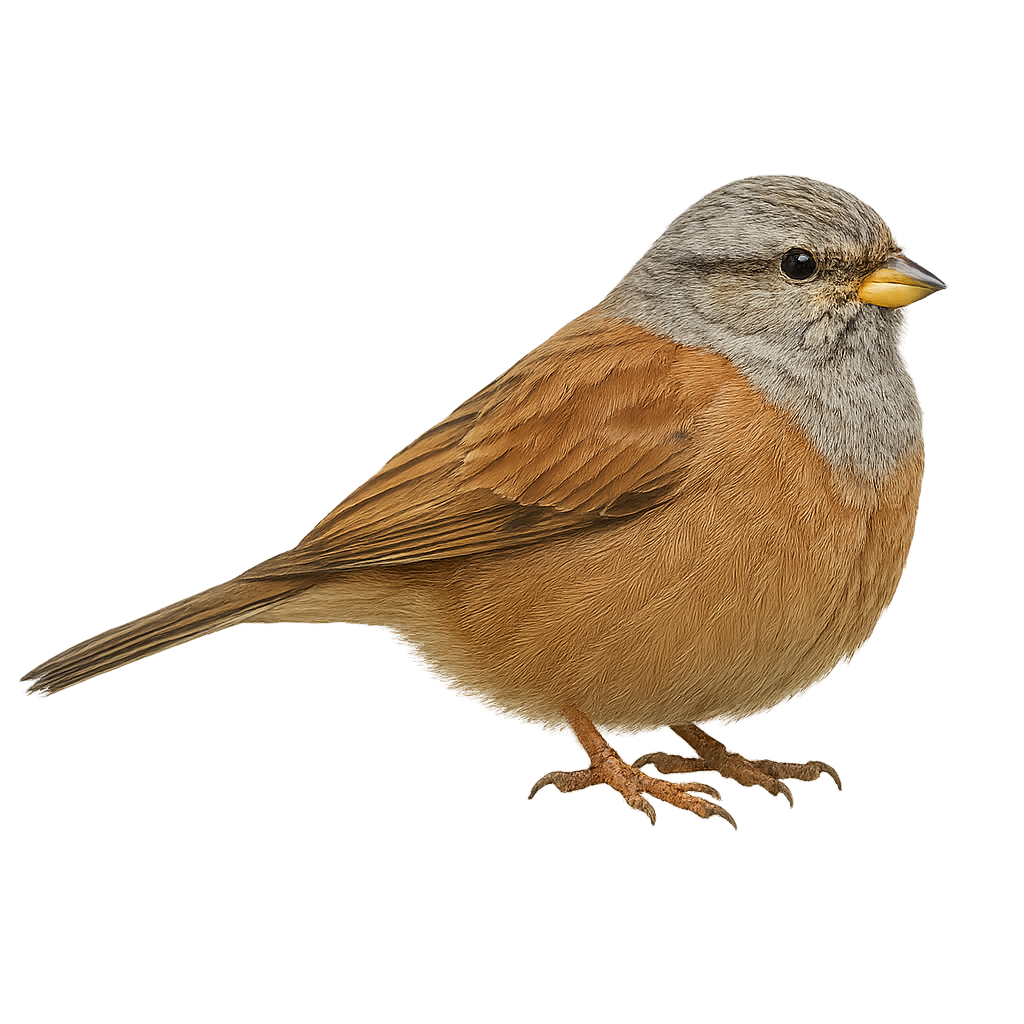The Eurasian bullfinch is a small, stocky passerine (14–16 cm) with bright pink-and-black plumage in males and more subdued tones in females. It inhabits mixed woodlands, hedgerows, and orchards across Europe and Asia, feeding on seeds and buds in winter and insects in spring. During the breeding season (April to July), the male utters soft calls from a perch and both partners build a sturdy nest of twigs and moss.
The Long-tailed Ground Roller, or Uratelornis chimaera, is an endemic bird species of Madagascar, remarkable for its appearance and behavior. This medium-sized bird, measuring about 30 cm in length, is notable for its long tail and brown speckled plumage, which provides effective camouflage in its natural habitat. Primarily terrestrial, it prefers running to flying and feeds on insects and small invertebrates found by foraging on the ground. The Long-tailed Ground Roller is a diurnal bird, active mainly in the morning and late afternoon. It is known for its melodious song, used to mark territory and attract a mate. Unfortunately, this species is threatened by habitat destruction due to deforestation.
The Crossley's Vanga is an endemic bird of Madagascar, belonging to the Vangidae family. It is distinguished by its colorful plumage, blending shades of blue, green, and black, and its robust, slightly hooked beak. This bird primarily inhabits the island's humid forests, where it feeds on insects and small invertebrates. Its melodious and varied song is often heard at dawn and dusk. Although its habitat is threatened by deforestation, the Crossley's Vanga is currently classified as "least concern" by the IUCN. However, it is essential to continue monitoring its populations to ensure its long-term conservation.
The Brown Mesite (Geobiastes squamiger) is a terrestrial bird endemic to Madagascar, part of the Mesitornithidae family. It is characterized by its uniform brown plumage, slightly lighter on the belly, and its white-ringed eyes. This elusive bird is primarily found in the island's dry and humid forests, where it feeds on insects and small invertebrates. The Brown Mesite is monogamous, living in pairs or small family groups. Its population is declining due to deforestation and hunting, making it vulnerable to extinction. Conservation efforts are crucial to ensure its long-term survival.
The Schlegel's Asity is an endemic bird of Madagascar, belonging to the Eurylaimidae family. This medium-sized bird features bright green plumage with bluish hues on its wings and tail. Males are distinguished by their striking blue collar around the neck, which becomes particularly prominent during the breeding season. Females, on the other hand, display duller colors, often olive green. The Schlegel's Asity primarily inhabits the island's humid tropical forests, where it feeds on fruits, insects, and small invertebrates. Its melodious and varied song echoes through the undergrowth, adding a sonic touch to its lush environment.
The Flightless Steamer Duck, or Tachyeres pteneres, is a waterfowl species endemic to the coasts of Patagonia in South America. Recognizable by its grayish plumage and large size, it is flightless, setting it apart from other ducks. This duck is mainly observed along rocky shores, where it feeds on mollusks and crustaceans. Males are generally larger than females and have a bright orange bill. Their territorial behavior is pronounced, especially during the breeding season. Although they are not very shy, they prefer isolated areas away from human disturbances. Their population is stable, but their habitat is vulnerable to environmental changes.
The Blue-winged Pitta, or Pitta moluccensis, is a colorful and captivating bird primarily found in Southeast Asia. It is distinguished by its vibrant plumage, with bright blue wings, a red belly, and a black head with a white stripe. Measuring about 20 cm, this bird prefers humid forests, mangroves, and wooded areas. It is often seen on the ground, searching for insects and invertebrates. Although discreet, its melodious song often gives it away. A migratory bird, it moves according to the seasons, seeking habitats conducive to its survival. Its population is stable, but deforestation poses a potential threat.
The Hooded Pitta, scientifically known as Pitta sordida, is a vibrant and captivating bird belonging to the Pittidae family. It is characterized by its striking plumage, featuring a black head, bright green body, and wings with blue and red hues. This bird is primarily terrestrial, moving nimbly through the undergrowth of Southeast Asian tropical forests. Known for its melodious song and loud calls, the Hooded Pitta feeds mainly on insects, small invertebrates, and fruits. It is often seen alone or in pairs, and its elusive nature makes it difficult to spot. Despite its beauty, it faces threats from habitat loss due to deforestation.
The Blue-headed Pitta, scientifically known as Hydrornis baudii, is a vibrant and elusive bird native to the tropical forests of Borneo. It is easily identified by its striking blue head and a body adorned with shades of brown and black. This small bird primarily feeds on insects and small invertebrates found in the forest litter. The Blue-headed Pitta is a solitary creature, often difficult to spot due to its secretive nature and dense habitat. Although its population is currently stable, deforestation poses a potential threat to its natural environment. Birdwatchers admire this species for its vivid colors and melodious song, though observing it often requires patience and stealth.
The Red-bellied Pitta, or Erythropitta erythrogaster, is a colorful and fascinating bird native to the tropical forests of Southeast Asia. Its striking plumage, predominantly red on the belly, contrasts with shades of blue and green on the back and wings, making it a visually impressive sight. This elusive bird prefers dense undergrowth where it primarily feeds on insects and small invertebrates. Although often difficult to spot due to its shy behavior, it is cherished by birdwatchers for its beauty and melodious song. The Red-bellied Pitta plays a crucial role in the ecosystem by controlling insect populations and aiding in seed dispersal.
The Malayan Banded Pitta, or Hydrornis guajanus, is a colorful and fascinating bird native to the tropical forests of Southeast Asia. This medium-sized bird is particularly admired for its striking plumage, which features a mix of blue, yellow, and black, with a distinctive band around the chest. The Malayan Banded Pitta is a discreet bird, often difficult to observe due to its shy behavior and dense habitat. It primarily feeds on insects and small invertebrates found in the forest litter. Although its song is melodious, it is rarely heard outside the breeding season. Deforestation poses a threat to its habitat, although the species is not currently considered critically endangered.
The Schneider's Pitta, or Hydrornis schneideri, is a colorful and elusive bird primarily found in the tropical forests of Southeast Asia. Its medium size and vibrant plumage, featuring shades of blue, red, and black, make it a subject of fascination for birdwatchers. This bird prefers dense undergrowth where it feeds mainly on insects and small invertebrates. Although its song is melodious, it is often difficult to spot due to its discreet behavior. The Schneider's Pitta is a sedentary bird, and its habitat is threatened by deforestation, leading to a decline in its population.
The Steere's Pitta is a colorful and rare bird, endemic to the Philippines, primarily found on the island of Mindanao. It is distinguished by its striking plumage, combining shades of blue, green, and red, giving it a spectacular appearance. This bird prefers dense tropical forests, where it feeds mainly on insects and small invertebrates. Unfortunately, deforestation and habitat loss threaten its survival, making it vulnerable. The Steere's Pitta is a discreet bird, often difficult to observe due to its shy behavior and isolated habitat. Protecting its natural habitats is essential to ensure its long-term preservation.
The Fairy Pitta, known scientifically as Pitta nympha, is a medium-sized bird renowned for its dazzling plumage that features shades of blue, green, red, and black. This migratory bird is primarily found in East Asia, particularly in China, Japan, and Korea. It prefers dense, humid forests where it feeds mainly on insects and small invertebrates. The Fairy Pitta is often difficult to spot due to its elusive behavior and dense habitat. It is currently classified as vulnerable due to habitat loss and increasing deforestation in its breeding and wintering areas.
The Green-crowned Brilliant, scientifically known as Heliodoxa jacula, is a medium-sized hummingbird found in the humid forests of Central America, from Costa Rica to Panama. Measuring about 11 to 12 cm, this bird is notable for its striking metallic green plumage and emerald crown. Males have a distinctive blue-violet throat, while females feature a white throat speckled with green. Their relatively short, slightly curved beak is well-suited for nectar feeding. These birds are often seen hovering near flowers, using their agility to access nectar while playing a vital role in pollination.
The White-throated Sparrow is a medium-sized songbird, easily identified by its distinctive white throat contrasting with its brown streaked plumage. It also features a yellow patch above each eye. Found mainly in North America, it inhabits mixed forests and dense undergrowth. Its melodious song is often heard in spring and summer. This sparrow is a partial migrant, moving to the southern United States in winter. It primarily feeds on seeds, insects, and berries. Pairs nest on or near the ground, hiding their nests under bushes or tall grasses. The White-throated Sparrow is a sociable bird, often seen in small groups, especially outside the breeding season.
The Chestnut-eared Bunting, Emberiza fucata, is a small bird from the Emberizidae family. It is easily identifiable by its distinctive chestnut ear patches and brown and gray plumage. This passerine bird primarily inhabits open areas such as grasslands and cultivated fields, feeding on seeds and insects. It is commonly found in Asia, especially in China, Japan, and Russia. During the breeding season, the male sings to attract a mate, subsequently building a well-hidden nest in low vegetation. Although its conservation status is currently "least concern," habitat destruction could pose future threats.
The Saltmarsh Sparrow is a small passerine bird that primarily inhabits the salt marshes of the eastern United States. It is recognizable by its brown plumage streaked with black, with orange hues on the face and chest. Its tail is long and pointed, giving it its name. This sparrow is a coastal habitat specialist, feeding mainly on seeds and insects. It is often seen moving stealthily among tall grasses, searching for food. Although discreet, its melodious song can be heard in the spring. Unfortunately, its habitat is threatened by urbanization and climate change, making it a conservation concern.
The Yellow-browed Bunting, Emberiza chrysophrys, is a small passerine bird belonging to the Emberizidae family. It is easily recognized by its bright yellow eyebrows contrasting with its brown, streaked plumage. This bunting inhabits coniferous forests and shrublands in Asia, particularly in Siberia and China. As a migratory bird, it winters in Southeast Asia. Its song is a melodious trill, often heard during the breeding season. Though discreet, it can sometimes be seen in small flocks. Its population is stable, but it is vulnerable to habitat loss due to deforestation.
The Yellow Bunting, or Emberiza sulphurata, is a small passerine bird belonging to the Emberizidae family. It is primarily found in the wooded regions of Japan, where it is endemic. This bunting is notable for its bright yellow head, contrasting with its brown back and striped wings. It inhabits deciduous forests and shrubby areas, often near watercourses. Its song is melodious, consisting of clear, repetitive notes. Though discreet, it is occasionally seen in small groups. Its population is declining due to habitat loss and forest fragmentation. Preserving its natural habitats is crucial for its survival.
The Cirl bunting is a small passerine in the bunting family Emberizidae, measuring 16–17 cm in length, with streaked brown plumage and a yellow head marked by a black crown and dark throat. It inhabits sunny grasslands, hedgerows and scrub, feeding mainly on seeds and insects. During breeding, it builds a nest in low bushes and the male sings from an exposed perch to attract the female and defend its territory.
The Botteri's Sparrow is a small, inconspicuous bird primarily found in the grasslands and shrublands of the southern United States and Mexico. It is characterized by its dull brown plumage, which allows it to blend into its surroundings. This passerine prefers open habitats with low vegetation, where it feeds on seeds and insects. Its song, though simple, is a key aspect of its territorial behavior. During the breeding season, the male often sings from a low perch to attract a mate. Despite its modest appearance, the Botteri's Sparrow plays an essential role in the ecosystem by contributing to seed dispersal and insect population control.
The Brewer's Sparrow is a small passerine bird known for its subtle plumage and modest size. It features a brown back with dark streaks, a lighter belly, and a gray head with fine stripes. This sparrow is primarily found in the arid and semi-arid regions of western North America, where it inhabits shrublands and open grasslands. It is renowned for its melodious song, often heard during the breeding season. The Brewer's Sparrow is a migratory bird, spending its winters in the southwestern United States and northern Mexico. Although relatively common, its habitat is threatened by urban expansion and intensive agriculture.
The Lincoln's Sparrow, Melospiza lincolnii, is a small passerine bird belonging to the Passerellidae family. It is primarily found in North America, inhabiting wetlands, meadows, and open forests. This sparrow is identifiable by its brown plumage streaked with black and its finely streaked chest. Its head features a gray cap and a brownish eye stripe. Often heard before seen, it is known for its melodious and complex song. A migratory bird, it winters in the southern United States and Mexico. Its elusive nature and shy behavior make it a challenging subject for birdwatchers.
The Nelson's Sparrow, or Ammospiza nelsoni, is a small passerine bird primarily inhabiting the salt marshes and wet meadows of North America. It is recognizable by its distinctive plumage, featuring a gray-blue head, orange cheeks, and black streaks on its back. This sparrow is a migratory bird, breeding in northern regions and wintering along the Atlantic coast. It primarily feeds on seeds and insects, which it finds by foraging in dense vegetation. Although relatively discreet, its melodious song is often heard in spring. The Nelson's Sparrow is a vulnerable species due to the loss of its natural habitat, caused by marsh drainage and coastal development.
The Swamp Sparrow, or Melospiza georgiana, is a small passerine bird belonging to the family Passerellidae. It is primarily found in North America, frequenting wetlands such as marshes and lake edges. This sparrow is distinguished by its reddish-brown plumage on the back and gray on the belly, with a rusty cap and dark streaks on the wings. Known for its melodious song, it is often heard in spring and summer. The Swamp Sparrow is a migratory bird, wintering in the southern United States and Mexico. It feeds mainly on seeds, insects, and small invertebrates, which it finds by foraging in the moist ground.
The Snow Bunting, or Plectrophenax nivalis, is a bird from the Calcariidae family. It is easily recognizable by its white and black plumage, which allows it to blend into snowy landscapes of the Arctic and mountainous regions. In summer, it has darker plumage on its back and wings, while its belly remains white. This migratory bird breeds in Arctic and subarctic regions and migrates south in winter, sometimes reaching the northern coasts of Europe and North America. It primarily feeds on seeds and insects, which it finds by foraging on the ground. The Snow Bunting is a sociable bird, often seen in flocks, especially outside the breeding season.
The reed bunting is a small passerine bird found primarily in wetlands, reed beds, and marshes across Europe, Asia, and North Africa. It is easily recognized by its streaked brown plumage, light belly, and distinctive markings on the head, particularly the black-and-white patterns. This small bird primarily feeds on seeds and insects found in grasses and reeds.
The House Bunting, or Emberiza sahari, is a small bird with a discreet plumage, mainly brown with shades of gray and beige. It is well adapted to arid and semi-arid environments, blending perfectly into the landscape. It is primarily found in North Africa, especially in desert and mountainous regions. Known for its melodious song, often heard at dawn, it feeds mainly on seeds but can also consume insects, especially during the breeding season. The House Bunting is a sociable bird, often seen in small groups, and is relatively not very shy, making it accessible for observation.
The Chipping Sparrow, or Spizella passerina, is a small songbird common in North America. It is easily identified by its rufous cap, gray cheeks, and black eye line. Its plumage is primarily brown with streaks on the back, while the underside is lighter. It inhabits open areas, gardens, and parks, often near human settlements. This sparrow is known for its simple yet melodious song, often heard in spring and summer. It primarily feeds on seeds and insects, which it finds on the ground or in shrubs. During the breeding season, it builds a cup-shaped nest in shrubs or low trees.


